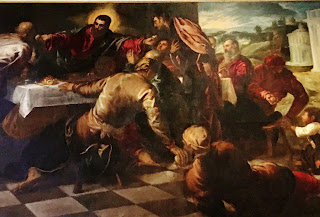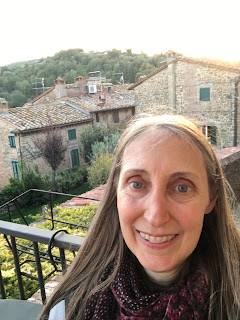So Pope was shocked when, in Venice, I decided to take the Tintoretto walking tour.
Who is Tintoretto, some of you might ask. Well, I'm pleased to inform you that you can see for yourself: his religious paintings will be featured at the National Gallery of Art in Washington, DC, in March 2019.
Meanwhile, I'm pleased to provide a tiny glimpse of Renaissance culture and the heyday of Jacopo Tintoretto. Very tiny, because even with a good map the paintings weren't easy to find. But that's okay; it's a good excuse to show you photographs of my trip.
First, I practiced Renaissance-cathedral-hopping in Florence, starting with the Duomo--which is by Brunelleschi, an architect, not Tintoretto, the painter; but that's ok, all those Italian artists run together for the average American sightseer like me.
The Cathedral of Florence, or Basilica di Santa Maria del Fiore, was begun in the Gothic style in the late 1200s, but became a hallmark of Renaissance architecture by the time its imposing dome was completed in the mid-1400s
Crowds gather to view the sunset every evening at Michelangelo Plaza, across the river and a steep climb high above the city; it's not old, though, it was built in the late 1800s
A series of staircases carry you up, up, up above Michelangelo Plaza to another level of history
Santa Miniato al Monte features the usual marble embellishments, but also a gold mosaic; the church is not Renaissance, however, it's Romanesque, which is an earlier period; the church was begun in 1018 and predates Michelangelo Plaza by 800+ years
These were pleasant diversions. But this blog post is supposed to be about Tintoretto and the Renaissance.
I got to Venice a day earlier than Pope and strolled over to see the marble columns of Annunciaton Church, around the corner from our AirBnB in the Cannaregio district. It is Baroque, not Renaissance. Still pretty, though. I couldn't get inside to look for Tintorettos.
Annunciation Church, or Chiesa dei Gesuiti
The primary Venice attraction, St. Mark's Cathedral, is also Byzantine; the current structure was started around 1063--long before the Italian Renaissance. In my view (and Pope's), however, it is not pretty but a somewhat grotesque abomination of architecture. And the crowds were shoulder-to-shoulder. After a brief obligatory look-see, we fled for quieter neighborhoods, me in pursuit of Tintoretto and Pope in pursuit of good wine.
Piazza San Marcos and the basilica in mid-October draws thousands of cruise ship passengers and large Asian tour groups
What did intrigue me at St. Mark's were the mysterious wooden boardwalks that wind around the plaza, a couple of feet above ground. At the time, there was no obvious explanation. I discovered what they were only a week later, back home, when photos of a flooded Venice flooded the news media. (Reuters Photo)
Aha! That's what those raised platforms are for... This photo is from Reuters, Oct 29, 2018--a week after we left
Having disposed of the most important tourist attraction in Venice, Pope retired to an afternoon siesta while I strolled the city with my Tintoretto walking tour map, in search of illustrious paintings and glorious Renaissance architecture.
After a while, I came upon another famous Venetian church: Friari. This cathedral is Gothic, not Renaissance, and its famous altar painting is not a Tintoretto but a light-splashed Titian's Assumption. Balancing--or spoiling--the subtle red-and-blue beauty of Titian's masterpiece is a gaudy gilt monstrosity built to house religious relics, and some ostentatious and uncomfortable-looking wooden choir pews.
Santa Maria Glorioso del Friari, from the 1400s-1500s: gilded altar for relics, and choir loft
What intrigued me most at Friari were four massive statues of African slaves--probably the source of labor for construction of the cathedrals and a closely-kept secret of Venetian history. Symbolically depicted in black marble under the weight of white marble, frowning fiercely, you won't find these slaves mentioned in tour books or tourist websites. However, I found some interesting speculation about the possible intent here.
The giant statues may have represented the defeat of the Ottoman Empire; or was the depiction of their angry visages an early anti-slavery statement?
Altogether, I made it to a dozen cathedrals and palaces, of which six or seven actually did feature Renaissance architecture and Tintoretto paintings--some interesting and some not-so-interesting, but none that convinced me to drop everything and study Italian Renaissance art. Or even to bore you with pictures. Pope stayed away, frequenting cafes and bars while I pounded the pedestrian lanes.
One of Tintoretto's paintings is worth a mention. It's a Last Supper. Every Italian painter worth his oils had to paint one, right? Tintoretto alone has six or seven in Venice, including a glowing light-and-angel-filled one at the Basilica di San Giorgio Maggiore, which is on many tourist agendas. I didn't make it there; it's a dramatic painting but obnoxiously religious, and it requires a boat ride to a separate island.
This Last Supper is different. It's at the Church of San Polo, and the gloomy interior of the church makes it difficult to see. At first glance it appeared to be a raucous, chaotic party of drunkenness and delusion, with Christ pushing hotheads apart and with other revelers rolling on the floor. Up close and after careful study, though, one can discern that it's actually an open-air feast at which a haloed Christ is holding out bread to disciples at far ends of the table, and others are offering bread to a man and boy on the ground. (This photo is significantly brightened from my original shot.)
This version of the Last Supper, by Tintoretto, dates to the late 1500s and is housed at the Chiesa di San Paolo Apostolo in the San Polo neighborhood
I had to chuckle. So many serious religious paintings in one city can be oppressive. At least one of those on my Tintoretto walking tour offered some light entertainment.
































